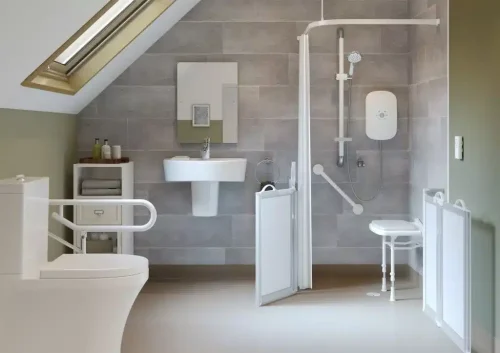Inside, you’ll learn:
✔️ Practical home adaptations to improve mobility, safety, and comfort
✔️Expert advice on making bathrooms, kitchens, and bedrooms disability-friendly
✔️ Key accessibility features such as level access showers, grab rails, and non-slip flooring
✔️ Recommended aids and equipment for elderly and disabled individuals
✔️ Tips for adapting your home for wheelchair access and limited mobility.
Creating a home that’s safe, comfortable, and accessible for disabled or elderly individuals doesn’t have to be complicated.
Whether it’s due to ageing, injury, illness, or long-term disability, the right home adaptations can make a world of difference in promoting independence and quality of life.
From choosing a shower for wheelchair users to installing disabled wet room flooring, let’s explore the essential changes that can make your home more inclusive.
Stair Access
Stairs are one of the biggest obstacles for those with limited mobility. If your home has multiple floors, consider:
- Installing a stairlift or vertical lift
- Rearranging the home to move bedrooms and bathrooms to the ground floor
Using sturdy handrails on both sides of the staircase
Doors and Hallways
Standard doorways are often too narrow for wheelchair access. Make sure:
- Doorways are at least 900mm wide (standard wheelchairs are 635mm)
- Hallways allow for easy turning and obstruction-free access
- Thresholds are lowered or removed to prevent tripping

Bedroom
One of the simplest ways to make a bedroom much more comfortable is to look at choosing a bed that fits your needs. It could be a simple change such as buying a firmer mattress, looking at investing in memory foam if you suffer from joint or mobility problems, or even buying a brand-new bed. Adjustable beds can make a huge difference for the many who find themselves bedroom bound for a greater part of the day. They can be adapted to suit your needs at different times.
For instance, they can always be adjusted to make it comfortable to sit up and read or watch TV with the simple press of a button.
Here are some adaptations you could use in the Bedroom:
- Overbed Table – This is very versatile and has plenty of uses from eating in bed to reading. This table can be easily wheeled in and out of place when required.
- Security Pole – This pole provides the user with the stability and security of being able to get up from a sitting or laying down position. This is perfect for bedroom use.
- Bed Rail – Provides you support with getting in and out of the bed. It also prevents you from rolling off the bed as well.
- Lowering Wardrobe Rail – This is done so that you can access your close from a lower height, which will be more suitable for wheelchair users.
Bathroom
Having a bathroom that suits your needs for you or your loved ones is key. You can design a bathroom to have everything you could possibly need.
Maybe you need plenty of access for a wheelchair; if this is the case a disabled wet room might be the best option.
This will mean taking out your bath/shower and transforming the bathroom into a wetroom. You have plenty of options from grab rails to a specialised bath. Having a bathroom that gives you comfort and confidence can be a great addition to your home.
Here are some adaptations you could use in the Bathroom:
- Level Access Shower – This is perfect for those with disabilities, with plenty of room for wheelchair access and walking aids.
- Wet Room – Complete bathroom in which we install anti-slip flooring, sealed floors and walls, to keep the water in the bathroom. The current bath or raised shower unit then they can be removed, then the same drainage point can be used.
- Walk-In Shower – No more stepping in and out of the bath, these are perfect for those with disability and mobility issues.
- Easy Access Baths – No more stepping in and out of the bath, these baths come with a door on the bath for easy access.
- Bathroom Accessories – Assistance poles, Grab rails, Seats, Safety glass, Anti-slip flooring.
Final Thoughts
Home adaptations for the disabled aren’t just about safety — they’re about regaining independence, maintaining dignity, and improving everyday life. Whether temporary or long-term, the right modifications can make a profound impact.
If you’re considering adapting your home, our team at Age Care Bathrooms is here to help with expert advice, installation of mobility-friendly bathrooms, and full support from consultation to completion.
Age Care Bathrooms
Age Care Bathrooms are the UK’s leading Independent Mobility Bathroom and Shower Specialists. We pride ourselves on being a family-run, independent company specialising in providing bathroom solutions for those with limited mobility. We cater to all ages and levels of disability. The Age Care Bathrooms team have been serving the mobility and disability communities for over 20 years. Age Care Bathrooms can help with a variety of services. If you’re looking for a level access shower or a complete mobility bathroom transformation, our team would love to hear from you to see how we could help. For a free quote today please call us on 0800 808 5897 or fill in our contact form.
